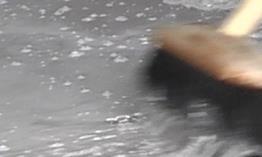PRODUCT TRAINING
Click here to book product training or call +44(0)1482 328053.
More info
Due to the manufacturing and production methods of iron and steel, they have a surface condition which is not compatible with the application of paint coatings. Steel in particular, has a dark appearance which results from a surface layer of mill scale. It is essential to eliminate all traces of mill scale and corrosion prior to the application of paints. There are several methods of cleaning the surface of rust and scale.
Chipping: Chipping by manual or mechanical means is usually in conjunction with wire brushing, but is not suitable for preparation of substrates to be overcoated with high performance paint systems such as 2 pack epoxy high build coatings. It can be used to remove thick rust scale before subsequent blasting or other preparation.
Flame Cleaning: Flame cleaning can be used to remove scale but not rust.
Wire Brushing: Wire brushing is a conventional method of preparation, usually carried out with rotating or hand wire brushes. It is not suitable for the removal of mill scale. The wire brushed surfaces are not completely free of corrosion. They tend to be polished and contaminated with oil, which decreases the adhesion of the priming paint affecting performance of the paint system. Disc sanding is usually required to complete the preparation and is even better to start and finish the work.
Sweep or Light Blast Cleaning: Sweep or light blast cleaning is a manual operation to remove any light rust and surface contamination from a coated steel surface.
Blast Cleaning: Blast cleaning involves forcing a stream of abrasive particles at high speed against the surface to be prepared. It can either be hand operated or automatic and is the best method of preparation. The most common types used are centrifugal, compressed air and vacuum blast cleaning. Commonly two types are used; “shot” where the particles are mostly spherical and should contain only a minimum of irregular shapes and “grit”, where the particles show angularity of form and have shape cutting edges. Unless otherwise specified, mineral grit should always be used.